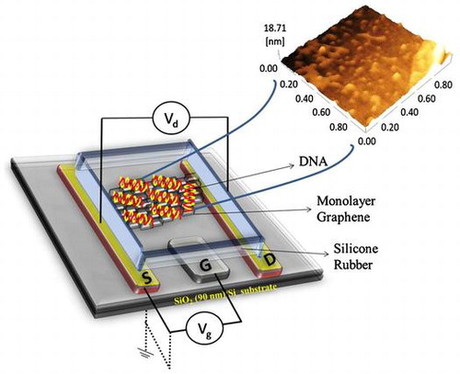Graphene transistors to detect genetic diseases

Japanese and Indian scientists have developed a method for using graphene-based transistors to detect disease-causing genes.
Graphene field-effect transistors (GFETs) can detect harmful genes through DNA hybridisation, which occurs when a ‘probe DNA’ combines, or hybridises, with its complementary ‘target DNA’. Hybridisation is usually detected by labelling the target with a fluorescent dye, which shines brightly when it combines with its probe (thus signalling a change in electrical conduction). But this involves a complicated labelling procedure and needs an expensive laser scanner to detect fluorescence intensity.
Researchers led by Nobutaka Hanagata, of Japan’s National Institute for Materials Science, sought to improve this method by attaching the probe DNA to the transistor through a drying process. They designed GFETs that consist of titanium-gold electrodes on graphene deposited on a silicon substrate. Then they deposited the DNA probe, in a saline solution, onto the GFET and left it to dry.
This drying process led to direct immobilisation of the probe DNA on the graphene surface without a need for linkers, ie, nucleotide sequences which are commonly used to attach probes to transistors. The target DNA, also in saline solution, was then added to the transistor and incubated for four hours for hybridisation to occur.
Writing in the journal Science and Technology of Advanced Materials, the researchers revealed that the GFET operated successfully using this preparation method. A change in electrical conduction was detected when the probe and target combined, signalling the presence of a harmful target gene. Conduction did not change when other non-complementary DNA was applied.
The newly developed GFETs could thus become a cheaper, easier to operate and more sensitive alternative for detecting genetic diseases, with the authors stating: “Further development of this GFET device could be explored with enhanced performance for future biosensor applications, particularly in the detection of genetic diseases.”
Blood-based biomarker can detect sleep deprivation
The biomarker detected whether individuals had been awake for 24 hours with a 99.2% probability...
Epigenetic signature helps to diagnose rare breast tumour
The current way of diagnosing phyllodes tumours is to analyse their cellular features under a...
New instrument measures cardiovascular disease biomarkers
CVD-21 enables a 'liquid cardiovascular biopsy' for quantification of multiple...







